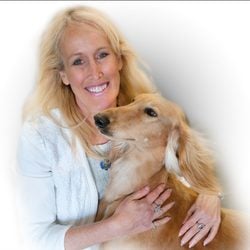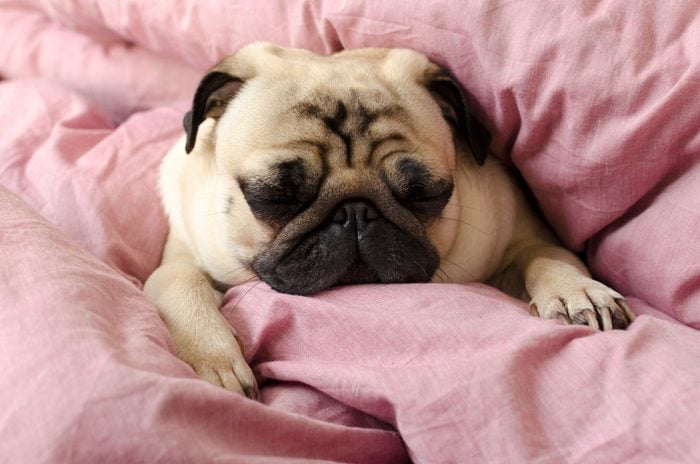
Lazy dogs for the win!
If you’re always on the go, you probably can’t wait to chill out at the end of a long day. And what better way to ensure that happens than by having a sleepy, snuggly, lazy dog waiting for you at home, just waiting to curl up by your side? Sean Prichard, president of the canine fitness and adventure company Pant & Wag, understands this all too well. After spending his days with rambunctious pups, Prichard doesn’t have the stamina for a dog with high exercise needs. “I wanted a very low-energy dog,” he says. That’s why he chose a greyhound named Noodles as his canine companion.
Low-energy dogs (aka lazy dogs) like Noodles are content with one or two leisurely walks a day or are small enough to burn off their energy indoors, and they are champions at napping. These couch-potato pups tend to be found in the toy, hound and non-sporting dog groups, Prichard says, and you’ll find some of the most popular dog breeds in their ranks.
So which dogs are lazy in all the best ways—and perfect for you? We spoke to Prichard and five other dog experts, ranging from veterinarians to trainers, to get the lowdown on the laziest breeds. Ahead, you’ll find out which dogs take lounging to a whole new level, as well as what other traits might make them a good fit for you.
Get Reader’s Digest’s Read Up newsletter for more pets, cleaning, humor, travel, tech and fun facts all week long.
About the experts
|
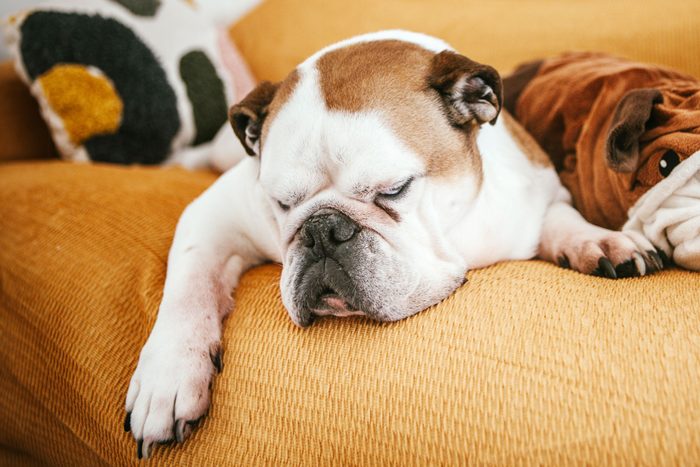
English bulldog
These lazybones, as Prichard affectionately calls them, are real charmers with their signature underbites and goofy grins. And they’re true homebodies—happiest when lounging with their furry and human family members. While they may enjoy two leisurely 15-minute walks a day, their flat or squishy faces (technically classified as brachycephalic) limit their exercise and heat tolerance. As a result, naps, cuddles and indoor play in air conditioning reign supreme for this bulldog breed, especially in hot weather.
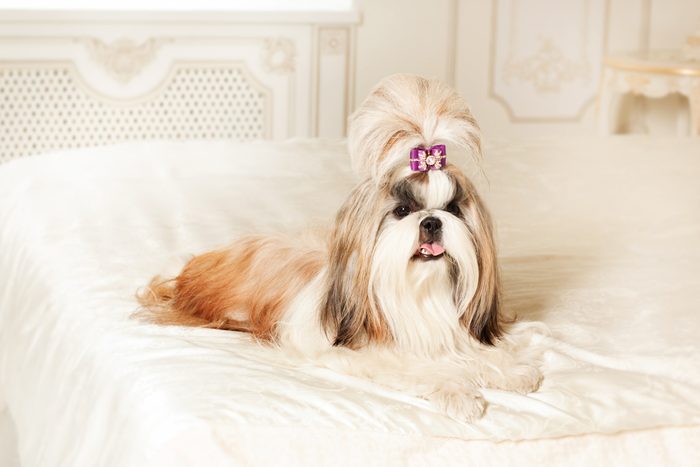
Shih Tzu
Generally speaking, some of the laziest dog breeds are from the toy and non-sporting groups, Prichard says. The Shih Tzu is a great example. These toy dogs were bred to look like little lions yet have the calm temperament suited for the companionship of Chinese royalty. While they have lots of energy, they stand only around 9 to 10 inches at shoulder height, so their little legs don’t need much of a walk to get worn out. In fact, playtime on the living-room floor could do the trick, although they’ll enjoy at least one short walk a day for mental stimulation, during which they can sniff and explore their surroundings.

Pekingese
Another lion-like breed that was once pampered in the Chinese palaces, the Pekingese is a self-assured little dog. But these lazy dogs are not the types to run amok, which is no surprise given their dignified history and the fact that they were bred for companionship, not athleticism. But one endearing quirk persists: their adorable snuffling and snoring. This is due to their flat faces, which also means they should stick to light or moderate exercise (think: a slow-paced sniff walk, a short walk or indoor playtime), especially in hot weather.
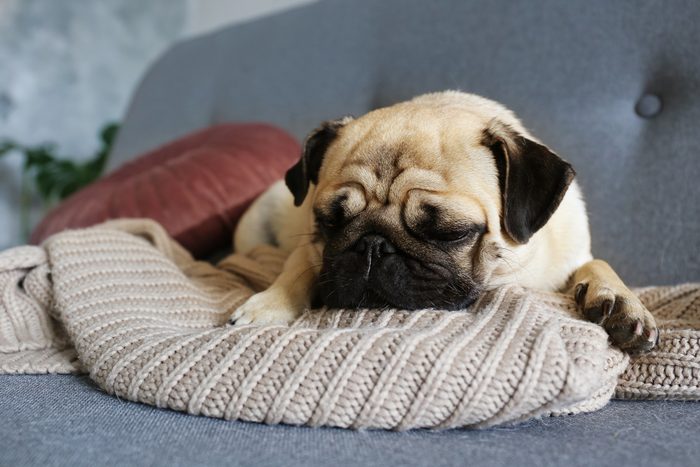
Pug
The biggest pug challenge? Resisting their snuggles when you need to leave the house and can’t take them with you! Whether a pure breed or pug mix, these lovable goofballs are down for anything low-key—namely, a TV marathon or playing indoors with their favorite toys (especially ones that dispense treats!). In fact, their passion for food rivals their napping skills, so make sure to balance all those naps with gentle play, a short walk and portion-controlled meals because they can easily become overweight.
“Unlike many other breeds, pugs were not bred for hunting, herding or other work,” explains Shannon Barrett, DVM, a veterinarian based in South Carolina. “Their primary role has always been as companion animals.” When they do get a burst of energy, though, be prepared for some silly zoomies. “It’s hilarious to watch,” says dog trainer Shane Gentry, owner of Sally Said So Professional Dog Training in Raleigh, North Carolina. “[But] the zoomies won’t last long, and your dog will be back in your lap in moments.”
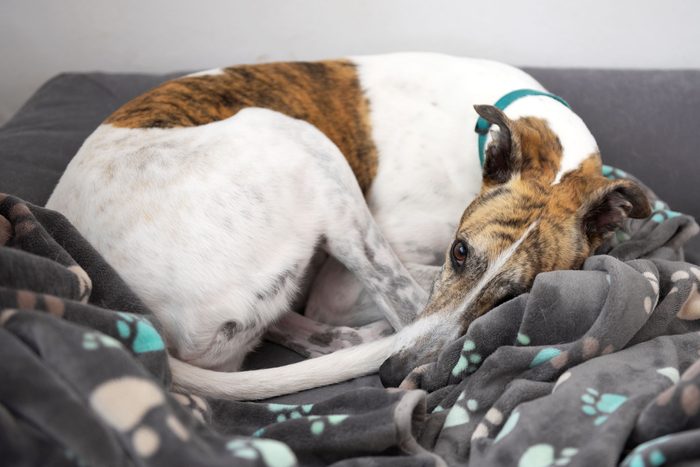
Greyhound
Greyhounds may be the fastest dogs in the world (reaching up to 40 mph!), but the only place they’ll probably try to outrun you is to the comfiest seat in the house. “It’s largely a myth that greyhounds need to run,” Prichard says. “They’d rather nap on the couch.” However, they still have their breed’s lightning-fast reflexes and a playful prey drive, so keep your greyhound on a leash during walks to avoid any surprise bursts of speed.
When it comes to exercising, Prichard recommends two to three short walks for sniffing and bathroom breaks, totaling about 60 minutes and half a mile. Unlike active breeds such as Australian shepherds and border collies, which might run five miles in an hour during Prichard’s class, a greyhound’s daily preferred exercise usually involves a leisurely stroll.
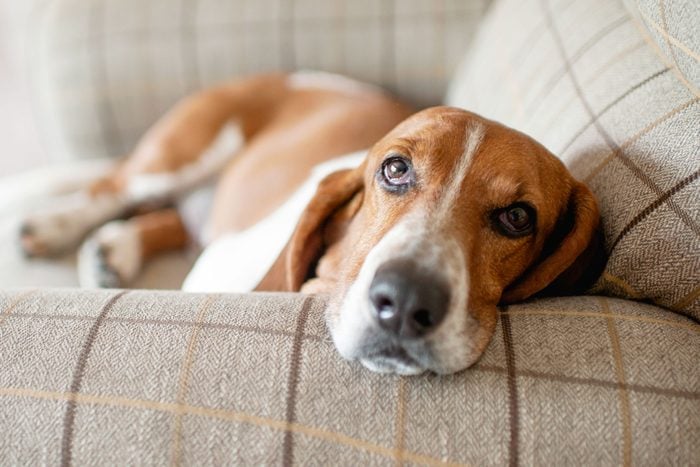
Basset hound
With soulful eyes and droopy ears, the basset hound is a favorite among many, including Prichard, who considers them one of the laziest breeds around. Affectionate and easygoing, these hound dogs become friends with everyone—children, fellow dogs, cats and even strangers. A play date with a canine buddy can be a great hands-off way to wear them out, getting them ready for their long afternoon nap. Alternatively, one leashed walk a day with plenty of sniffs meets their exercise and mental-stimulation needs, according to the American Kennel Club (AKC). While basset hounds can be a bit stubborn, they’re far from the most challenging dogs to train.
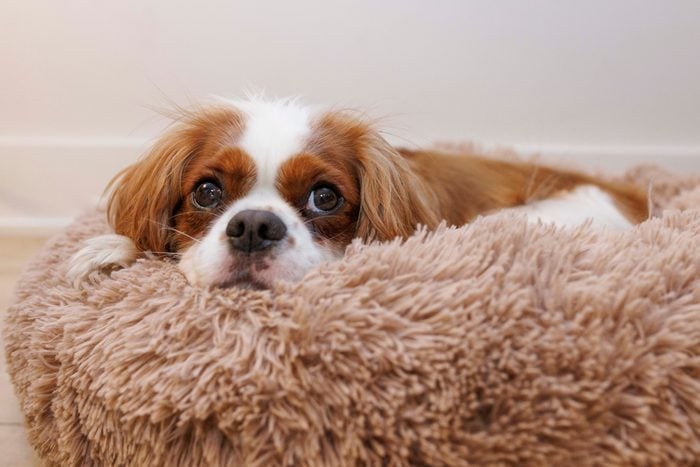
Cavalier King Charles spaniel
Unlike their gun-dog relatives, these adorable floppy-eared spaniels are more interested in cuddles than hunting. Their low prey drive means they’d rather curl up with the family cat than chase them around the house. In fact, companionship trumps chasing just about anything for these lazy dogs, though they’ll still require a 30- to 60-minute walk each day in addition to regular potty breaks, according to the Cavalier King Charles Spaniel Club. Descended from 16th-century ladies’ lapdogs in England, Cavaliers crave human company. Just like their ancestors, they’ll likely follow you everywhere—so watch your step.
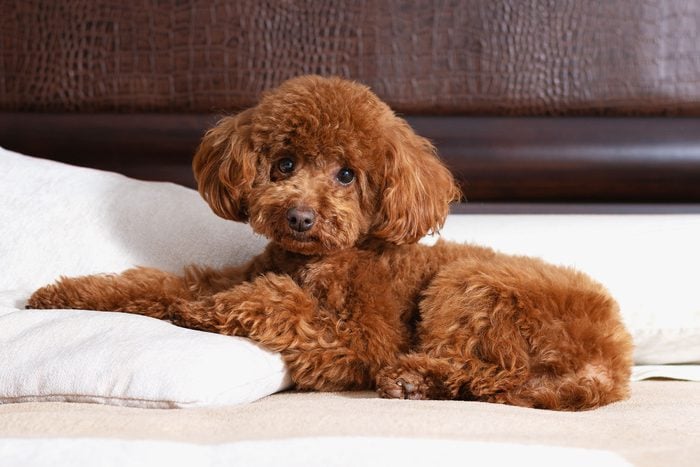
Toy poodle
“A smaller dog may need less exercise,” says Jennifer Phillips, a certified canine fitness trainer and the founder of Separation Anxiety Specialists. Their shorter legs may mean they tire quicker and require less space to play. And more often than not, toy poodles fill the bill. While energetic, they will generally be happy with two daily walks and indoor playtime chasing toys. Their larger standard and miniature poodle counterparts need more room to roam (think: lengthy hikes instead of short walks, and fetching Frisbees at the park rather than playing indoors).
The grooming needs of poodles are not for the faint of heart, though. That low-shedding coat grows and grows, requiring both daily brushing and routine trips to the groomer. But you’ll be rewarded with the cutest lapdog anyone could ask for.
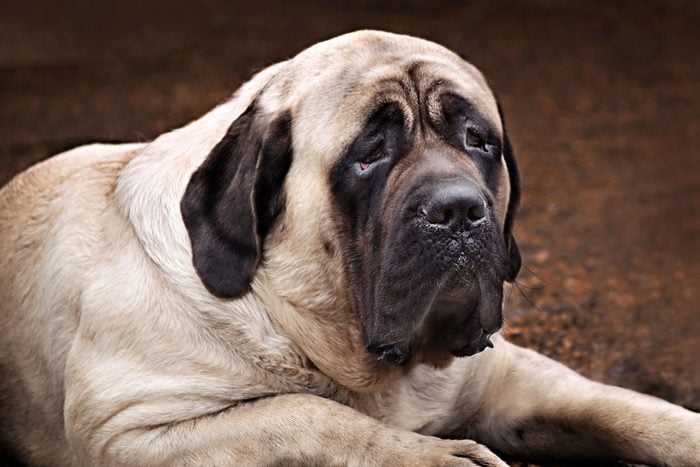
Mastiff
Some lazy dogs will never have the will or stamina to walk for miles, “like my mastiff,” says veterinarian Wendy Hauser, DVM, founder of Peak Veterinary Consulting. Topping out as the biggest pup on this list, the giant but gentle mastiff can weigh as much as 230 pounds and reach 30 inches in height—that’s one big couch potato! And believe it or not, these dogs were even taller 4,500 years ago when they lived in the mountains of Asia, according to the Mastiff Club of America. Later, their strength was put to good use pulling carts and guarding property in England and the Americas.
Due to their massive size, mastiff puppies shouldn’t be overexercised. The AKC recommends that growing puppies walk only up to a half of a block. Even adult mastiffs require little exercise, with one to two miles a day being sufficient. They’re great apartment dogs, and between naps, they enjoy playing with their toys.
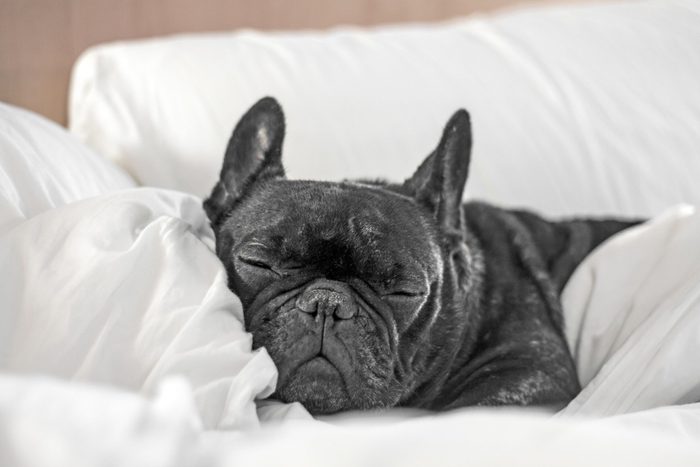
French bulldog
An occasional cuddle buddy with low exercise needs? Look no further than the French bulldog. Veterinarian Amy Attas, DVM, the founder of City Pets and author of Pets and the City: True Tales of a Manhattan House Call Veterinarian, says these affectionate pups bond strongly with their owners and don’t need a lot of mental stimulation or vigorous exercise. That makes them perfect for one-pet homes with single owners and/or apartment living. Two daily walks and some indoor playtime are all they need to stay happy.
So get ready to share your couch … but maybe grab some earplugs before you do. French bulldogs are champion nappers, clocking in up to 20 hours of sleep a day, and many are known to be enthusiastic snorers.
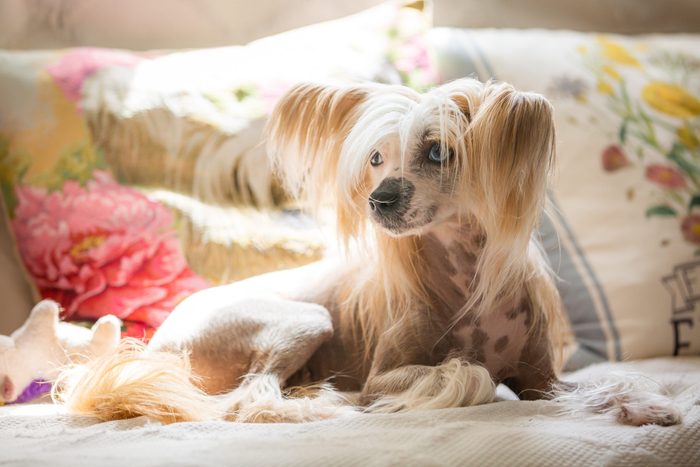
Chinese crested
When it comes to lazy dogs, you can’t go wrong with the Chinese crested. Their punk-rock hairdos makes these cuties look like they’re ready for a night out on the town, but we guarantee they’d rather spend a quiet evening curling up on the couch. They come in two varieties: the powderpuff, which has a soft, silky coat, and the hairless, known for its smooth skin and tufts of hair. While both have an easygoing exercise routine of one or two short walks outdoors and backyard or indoor play, according to the AKC, their grooming needs differ. Powderpuffs require daily brushing of damp hair (and only damp hair because dry brushing can damage their silky hair) and occasional baths. Hairless cresteds need more frequent baths, sunscreen and moisturizer to protect their sensitive skin.
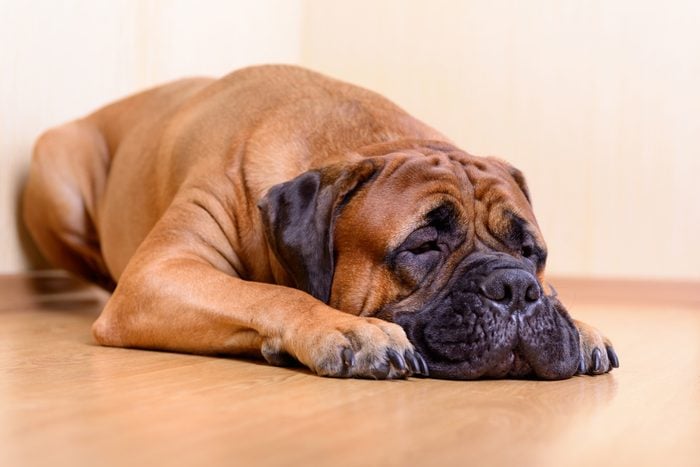
Bull mastiff
Bull mastiffs are a perfect combo of the extra-large yet gentle mastiff and the chummy bulldog. These dogs originated in 19th-century England and were bred to guard large estates, deterring poachers with their imposing size. It’s their breeding for patient guarding, rather than herding or other active work, that contributes to their lazy demeanor. Dr. Attas recommends a daily walk for these gentle giants, but otherwise, they’re content lounging at home.
While bull mastiffs can get excited, they generally remain gentle with smaller dogs and children. However, their size (over 100 pounds!) means proper training and socialization are crucial. Also, get ready for some—er, a lot of—drool.
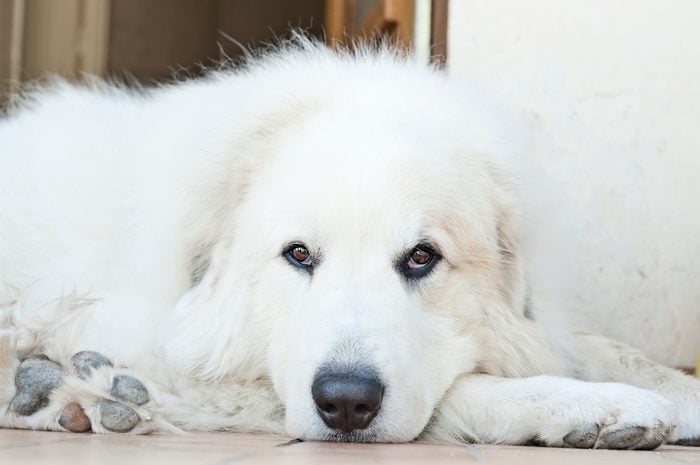
Great Pyrenees
As their name implies, Great Pyrenees grow to be fairly large, with male dogs reaching up to 100 pounds. But that just means more fuzz to snuggle up with! Though they have a robust appearance, these loyal companions were bred for guarding, not athleticism. Originally tasked with protecting sheep in the mountains, they are serious dogs that tend to like sitting back and observing. That said, they’ll appreciate an exercise routine of daily walks and even a weekend hike.
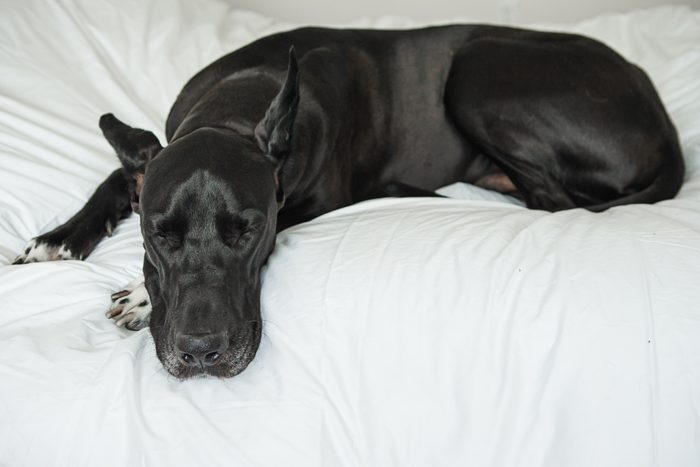
Great Dane
Great Danes’s impressive size means their growth needs careful management. This includes a large-breed diet and low-impact exercise like gentle walks. To protect their developing joints, Dr. Attas says to avoid activities like running on hard surfaces or jumping, particularly during the first two years. Luckily, Great Danes are happy to comply. “They are generally laid-back dogs who enjoy lounging about,” Dr. Attas says. Once your pup has reached the 18-month mark, they can build up endurance to be your jogging partner, if that’s your speed. Otherwise, adult Great Danes should be encouraged to go on walks two to three times a day, according to the AKC.
Because of their low exercise needs, they are surprisingly good apartment dogs, as long as they have access to ample space to stretch their long legs. However, you might need a bigger couch for this giant cuddle buddy!
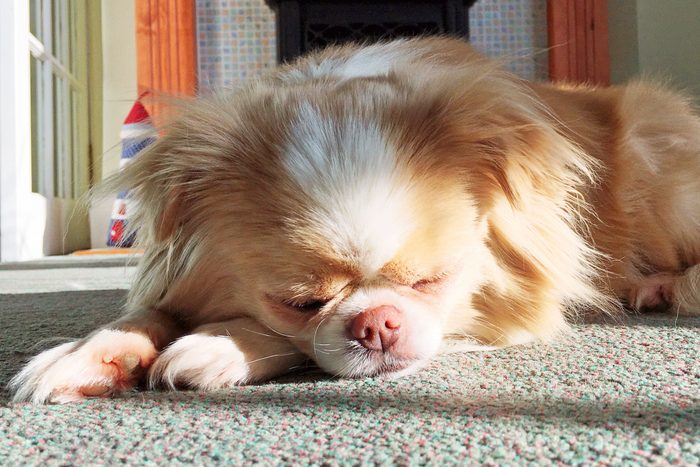
Japanese Chin
History tells us the Japanese Chin may be one of the laziest dog breeds. Their companionship with humans stretches back centuries, beginning as travel buddies on the Silk Road, according to the Japanese Chin Club of America. Content to warm laps and look darn cute doing it, they eventually found themselves pampered in imperial palaces between the 15th and 19th centuries. Thankfully, pampering your modern-day Chin is easy. They require minimal exercise and low-maintenance grooming—just a brush every other week.
Sometimes described as cat-like, Chins are affectionate yet independent. These regal companions can often be found grooming themselves, perched atop a lush couch cushion.
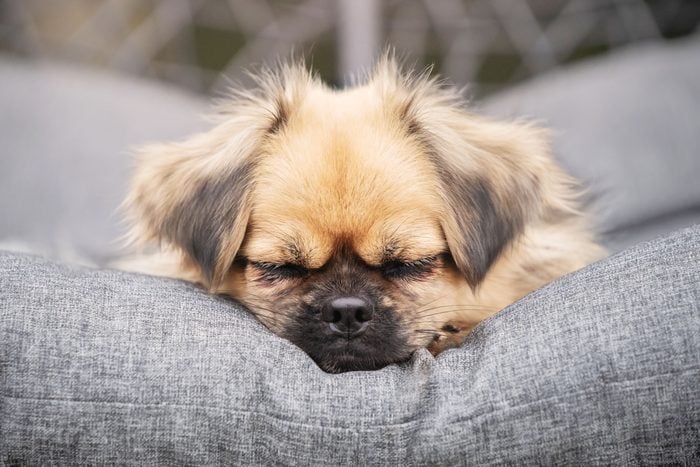
Tibetan spaniel
The Tibetan spaniel is a small but spunky dog, typically under 15 pounds and standing about 10 inches at shoulder height. This small size translates to minimal exercise needs; a daily walk or playtime session is enough to keep them happy. Their spunk actually stems back to their days as guard dogs in Tibetan monasteries, according to the Tibetan Spaniel Club of America. While they’re not yappy, they retain a watchful eye and a courageous spirit, ready to alert their humans when needed.
Not up for a daily grooming routine? That’s quite all right with Tibetan spaniels—their silky coats require only occasional brushing. Haircuts aren’t necessary, though trimming their fluffy paws is recommended.
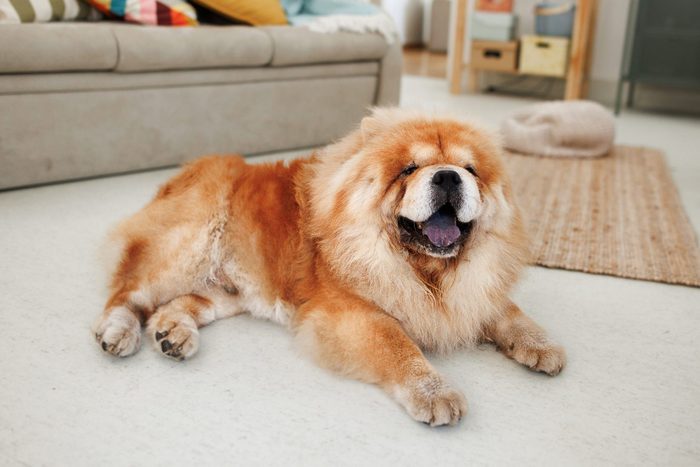
Chow chow
Chow chows have round faces, compact builds and impressively thick manes that give them a lion-like look. But while their fluffy appearances might tempt a cuddle, especially since they tend to sleep for more than half the day, these lazy dogs possess an independent, sometimes aloof, personality, Dr. Attas says. Don’t expect an overly clingy companion—cuddling up, playtime with other pets and boisterous behavior aren’t their forte.
Chow chows are an ancient breed thought to have originated from indigenous dogs about 8,300 years ago, as opposed to being selectively bred. Those who have researched this breed point to their unique physical traits as proof: All chows have a blue-black tongue, and some even have two extra teeth.
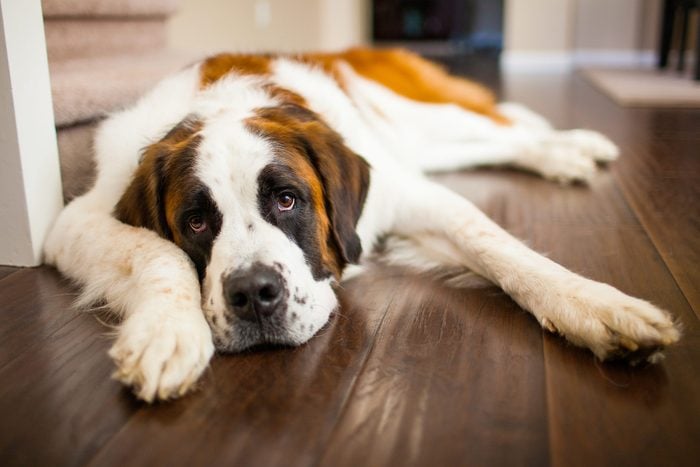
Saint Bernard
Saint Bernards are massive yet friendly dogs with a heart of gold. Standing as tall as 30 inches at shoulder height, they can weigh a whopping 180 pounds. Despite their size, these devoted companions are uber-gentle with people and other pets, including cats. As former search-and-rescue pups, Saint Bernards are some of the bravest dogs in history. But before setting your sights on the herculean breed, keep in mind that Saint Bernards are slow to mature. They can have puppy-like energy for up to two years before settling into a low-maintenance, lazy-dog routine of leisurely walks.
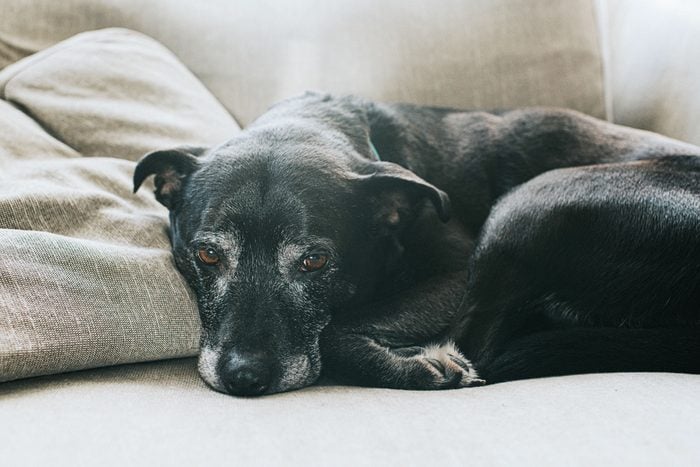
Adult and senior dogs
Not every adult dog is a leisurely walk in the park, but dogs do tend to mellow with age. “Puppies are active regardless of breed, and then the laziness sets in later in life, around age 2,” Prichard says. While some senior dogs might need more bathroom breaks compared to adult dogs, it will still be less frequent than puppies, who can only hold their pee for 30 minutes to a couple of hours, depending on their breed and age.
While senior dogs may enjoy lounging more than playing, they still benefit from daily walks. However, the pace and distance may need to be adjusted to their comfort level. Even a slower, shorter walk or one that requires a lift in a stroller or wagon is crucial for their well-being. “So if you really want a lazy dog from the first day you bring them home, consider adopting an older dog,” Prichard says.
Why trust us
At Reader’s Digest, we’re committed to producing high-quality content by writers with expertise and experience in their field, in consultation with relevant, qualified experts. For this piece on lazy dog breeds, Janelle Leeson tapped her experience as a pet health and behavior writer. Then Caroline Coile, PhD, an award-winning journalist specializing in canine breeds, health and science, gave it a rigorous review to ensure that all information is accurate and offers the best possible advice to readers. We verify all facts and data, back them with credible sourcing and revisit them over time to ensure they remain accurate and up to date. Read more about our team, our contributors and our editorial policies.
Sources:
- Sean Prichard, certified canine fitness coach, former certified professional dog trainer and current president and head canine fitness coach at Pant & Wag; email interview, Feb. 28, 2024, and March 11, 2024
- Amy Attas, DVM, veterinarian, founder of City Pets and author of Pets and the City: True Tales of a Manhattan House Call Veterinarian; email interview, March 4, 2024, and March 11, 2024
- Jennifer Phillips, founder of Separation Anxiety Specialists; email interview, Feb. 28, 2024
- Shane Gentry, certified dog trainer and owner of Sally Said So Professional Dog Training; email interview March 2, 2024
- Wendy Hauser, DVM, veterinarian, founder of Peak Veterinary Consulting and veterinary spokesperson at ASPCA Pet Health Insurance; email interview, March 4, 2024
- Sharron Barrett, DVM, veterinarian at Island Veterinary Care; email interview, March 21, 2024
- Cavalier King Charles Spaniel Club: “General History”
- Japanese Chin Club of America: “History of the Japanese Chin”
- Tibetan Spaniel Club of America: “About the Breed”
- The American Bullmastiff Association: “History of the Breed”

